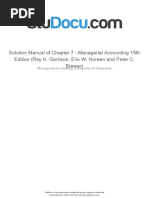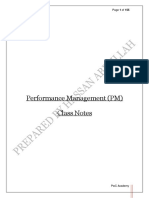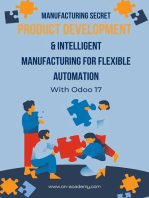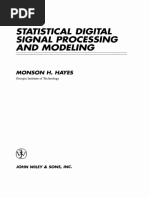Activity-Based Costing: A Tool To Aid Decision Making
Activity-Based Costing: A Tool To Aid Decision Making
Uploaded by
Tuan-Anh TranCopyright:
Available Formats
Activity-Based Costing: A Tool To Aid Decision Making
Activity-Based Costing: A Tool To Aid Decision Making
Uploaded by
Tuan-Anh TranOriginal Description:
Original Title
Copyright
Available Formats
Share this document
Did you find this document useful?
Is this content inappropriate?
Copyright:
Available Formats
Activity-Based Costing: A Tool To Aid Decision Making
Activity-Based Costing: A Tool To Aid Decision Making
Uploaded by
Tuan-Anh TranCopyright:
Available Formats
Chapter 07 Activity-Based Costing: A Tool to Aid Decision Making
7-1
Chapter 07
Activity-Based Costing: A Tool to Aid
Decision Making
Solutions to Questions
7-1 Activity-based costing differs from
traditional costing systems in a number of ways.
In activity-based costing, nonmanufacturing as
well as manufacturing costs may be assigned to
products. And, some manufacturing costs
including the costs of idle capacitymay be
excluded from product costs. An activity-based
costing system typically includes a number of
activity cost pools, each of which has its unique
measure of activity. These measures of activity
often differ from the allocation bases used in
traditional costing systems.
7-2 When direct labor is used as an allocation
base for overhead, it is implicitly assumed that
overhead cost is directly proportional to direct
labor. When cost systems were originally
developed in the 1800s, this assumption may
have been reasonably accurate. However, direct
labor has declined in importance over the years
while overhead has been increasing. This
suggests that there is no longer a direct link
between the level of direct labor and overhead.
Indeed, when a company automates, direct labor
is replaced by machines; a decrease in direct
labor is accompanied by an increase in overhead.
This violates the assumption that overhead cost is
directly proportional to direct labor. Overhead
cost appears to be driven by factors such as
product diversity and complexity as well as by
volume, for which direct labor has served as a
convenient measure.
7-3 Top managers provide leadership that is
needed to properly motivate all employees to
embrace the need to implement ABC. Top
managers also have the authority to link ABC data
to the employee evaluation and reward system.
Cross-functional employees are also important
because they possess intimate knowledge of
operations that is needed to design an effective
ABC system. Tapping the knowledge of cross-
functional employees also lessens their resistance
to ABC because they feel included in the
implementation process.
7-4 Unit-level activities are performed for
each unit that is produced. Batch-level activities
are performed for each batch regardless of how
many units are in the batch. Product-level
activities must be carried out to support a product
regardless of how many batches are run or units
produced. Customer-level activities must be
carried out to support customers regardless of
what products or services they buy. Organization-
sustaining activities are carried out regardless of
the companys precise product mix or mix of
customers.
7-5 Organization-sustaining costs, customer-
level costs, and the costs of idle capacity should
not be assigned to products. These costs
represent resources that are not consumed by the
products.
7-6 In activity-based costing, costs must first
be allocated to activity cost pools and then they
Chapter 07 Activity-Based Costing: A Tool to Aid Decision Making
7-2
are allocated from the activity cost pools to
products, customers, and other cost objects.
7-7 Because people are often involved in
more than one activity, some way must be found
to estimate how much time they spend in each
activity. The most practical approach is often to
ask employees how they spend their time. It is
also possible to ask people to keep records of
how they spend their time or observe them as
they perform their tasks, but both of these
alternatives are costly and it is not obvious that
the data would be any better. People who know
they are being observed may change how they
behave.
7-8 In traditional cost systems, product-level
costs are indiscriminately spread across all
products using direct labor-hours or some other
allocation base related to volume. As a
consequence, high-volume products are assigned
the bulk of such costs. If a product is responsible
for 40% of the direct labor in a factory, it will be
assigned 40% of the manufacturing overhead
cost in the factoryincluding 40% of the product-
level costs of low-volume products. In an activity-
based costing system, batch-level and product-
level costs are assigned more appropriately. This
results in shifting product-level costs back to the
products that cause them and away from the
high-volume products. (A similar effect will be
observed with batch-level costs if high-volume
products are produced in larger batches than low-
volume products.)
7-9 Activity rates tell managers the average
cost of resources consumed to carry out a
particular activity such as processing purchase
orders. An activity whose average cost is high
may be a good candidate for process
improvements. Benchmarking can be used to
identify which activities have unusually large
costs. If some other organization is able to carry
out the activity at a significantly lower cost, it is
reasonable to suppose that improvement may be
possible.
7-10 The activity-based costing approach
described in the chapter is probably unacceptable
for external financial reports for two reasons.
First, activity-based product costs, as described in
this chapter, exclude some manufacturing costs
and include some nonmanufacturing costs.
Second, the first-stage allocations are based on
interviews rather than verifiable, objective data.
Chapter 07 Activity-Based Costing: A Tool to Aid Decision Making
7-3
Exercise 7-1 (10 minutes)
a. Various individuals manage the parts inventories. Product-level
b. A clerk in the factory issues purchase orders for a
job. Batch-level
c. The personnel department trains new production
workers.
Organization-
sustaining
d. The factorys general manager meets with other
department heads, such as marketing, to
coordinate plans.
Organization-
sustaining
e. Direct labor workers assemble products. Unit-level
f. Engineers design new products. Product-level
g. The materials storekeeper issues raw materials to
be used in jobs. Batch-level
h. The maintenance department performs periodic
preventative maintenance on general-use
equipment.
Organization-
sustaining
Some of these classifications are debatable and may depend on the
specific circumstances found in particular companies.
Chapter 07 Activity-Based Costing: A Tool to Aid Decision Making
7-4
Exercise 7-2 (15 minutes)
Travel
Pickup
and
Delivery
Customer
Service Other Totals
Driver and guard wages ......................... $336,000 $378,000 $ 84,000 $ 42,000 $ 840,000
Vehicle operating expense ...................... 202,500 13,500 0 54,000 270,000
Vehicle depreciation ............................... 105,000 15,000 0 30,000 150,000
Customer representative salaries and
expenses ............................................ 0 0 153,000 27,000 180,000
Office expenses ..................................... 0 10,000 14,000 16,000 40,000
Administrative expenses ......................... 0 17,000 187,000 136,000 340,000
Total cost .............................................. $643,500 $433,500 $438,000 $305,000 $1,820,000
Each entry in the table is derived by multiplying the total cost for the cost category by the percentage
taken from the table below that shows the distribution of resource consumption:
Travel
Pickup
and
Delivery
Customer
Service Other Totals
Driver and guard wages ......................... 40% 45% 10% 5% 100%
Vehicle operating expense ...................... 75% 5% 0% 20% 100%
Vehicle depreciation ............................... 70% 10% 0% 20% 100%
Customer representative salaries and
expenses ............................................ 0% 0% 85% 15% 100%
Office expenses ..................................... 0% 25% 35% 40% 100%
Administrative expenses ......................... 0% 5% 55% 40% 100%
Chapter 07 Activity-Based Costing: A Tool to Aid Decision Making
7-5
Exercise 7-3 (10 minutes)
Activity Cost Pool
Estimated
Overhead
Cost Expected Activity Activity Rate
Caring for lawn $77,400 180,000 square feet of lawn $0.43 per square foot of lawn
Caring for garden beds
low maintenance
$30,000 24,000 square feet of low
maintenance beds
$1.25 per square foot of low
maintenance beds
Caring for garden beds
high maintenance
$57,600 18,000 square feet of high
maintenance beds
$3.20 per square foot of high
maintenance beds
Travel to jobs $4,200 15,000 miles $0.28 per mile
Customer billing and service $8,700 30 customers $290 per customer
The activity rate for each activity cost pool is computed by dividing its estimated overhead cost by its
expected activity.
Chapter 07 Activity-Based Costing: A Tool to Aid Decision Making
7-6
Exercise 7-4 (10 minutes)
J78
Activity Cost Pool Activity Rate Activity ABC Cost
Supporting direct labor ......... $7 per direct labor-hour 1,000 direct labor-hours $ 7,000
Machine processing .............. $3 per machine-hour 3,200 machine-hours 9,600
Machine setups .................... $40 per setup 5 setups 200
Production orders ................. $160 per order 5 order 800
Shipments ............................ $120 per shipment 10 shipment 1,200
Product sustaining ................ $800 per product 1 product 800
Total overhead cost .............. $19,600
W52
Activity Cost Pool Activity Rate Activity ABC Cost
Supporting direct labor ......... $7 per direct labor-hour 40 direct labor-hours $ 280
Machine processing .............. $3 per machine-hour 30 machine-hours 90
Machine setups .................... $40 per setup 1 setups 40
Production orders ................. $160 per order 1 orders 160
Shipments ............................ $120 per shipment 1 shipments 120
Product sustaining ................ $800 per product 1 product 800
Total overhead cost .............. $1,490
Chapter 07 Activity-Based Costing: A Tool to Aid Decision Making
7-7
Exercise 7-5 (15 minutes)
Sales ($1,650 per standard model glider 10
standard model gliders + $2,300 per custom
designed glider 2 custom designed gliders) ........ $21,100
Costs:
Direct materials ($462 per standard model glider
10 standard model gliders + $576 per custom
designed glider 2 custom designed gliders) ..... $5,772
Direct labor ($19 per direct labor-hour 28.5 direct
labor-hours per standard model glider 10
standard model gliders + $19 per direct labor-
hour 32 direct labor-hours per custom designed
glider 2 custom designed gliders) .................... 6,631
Supporting direct labor ($18 per direct labor-hour
28.5 direct labor-hours per standard model glider
10 standard model gliders + $18 per direct
labor-hour 32 direct labor-hours per custom
designed glider 2 custom designed gliders) ..... 6,282
Order processing ($192 per order 3 orders) ....... 576
Custom designing ($261 per custom design 2
custom designs) ................................................ 522
Customer service ($426 per customer
1 customer) ...................................................... 426 20,209
Customer margin .................................................... $ 891
Chapter 07 Activity-Based Costing: A Tool to Aid Decision Making
7-8
Exercise 7-9 (30 minutes)
1. Total revenue received:
City
General
County
General
Cost of goods sold to the hospital (a) ........... $30,000 $30,000
Markup percentage ..................................... 5% 5%
Markup in dollars (b) ................................... $1,500 $1,500
Revenue received from hospitals (a) + (b) .... $31,500 $31,500
2. Activity Rates:
Activity Cost Pool
(a)
Estimated
Overhead
Cost
(b)
Expected Activity
(a) (b)
Activity rate
Customer deliveries ............ $400,000 5,000 deliveries $80.00 per delivery
Manual order processing ..... $300,000 4,000 orders $75.00 per manual order
Electronic order processing . $200,000 12,500 orders $16.00 per electronic order
Line item picking ................ $500,000 400,000 line items $1.25 per line item picked
Chapter 07 Activity-Based Costing: A Tool to Aid Decision Making
7-9
Exercise 7-9 (continued)
3. Activity costs are assigned to the two hospitals as follows:
City General:
Activity Cost Pool
(a)
Activity Rate
(b)
Activity
(a) (b)
ABC Cost
Customer deliveries ............ $80.00 per delivery 10 deliveries $ 800
Manual order processing ..... $75.00 per order 0 orders 0
Electronic order processing . $16.00 per order 10 orders 160
Line item picking ................ $1.25 per line item 100 line items 125
Total activity costs .............. $1,085
County General:
Activity Cost Pool
(a)
Activity Rate
(b)
Activity
(a) (b)
ABC Cost
Customer deliveries ............ $80.00 per delivery 20 deliveries $1,600
Manual order processing ..... $75.00 per order 40 orders 3,000
Electronic order processing . $16.00 per order 0 orders 0
Line item picking ................ $1.25 per line item 260 line items 325
Total activity costs .............. $4,925
Chapter 07 Activity-Based Costing: A Tool to Aid Decision Making
7-10
Exercise 7-9 (continued)
4. Customer margins for the two hospitals:
City
General
County
General
Sales .................................... $31,500 $31,500
Cost of goods sold ................. 30,000 30,000
Gross margin ......................... 1,500 1,500
Customer deliveries ............... 800 1,600
Manual order processing ........ 0 3,000
Electronic order processing .... 160 0
Line item picking ................... 125 325
Total activity costs ................. 1,085 4,925
Customer margin ................... $ 415 $(3,425)
5. Hospitals that require frequent deliveries, place a high volume of manual
orders, and order many line items are likely to be unprofitable.
Chapter 07 Activity-Based Costing: A Tool to Aid Decision Making
7-11
Problem 7-16 (20 minutes)
1. The cost of serving the local commercial market according to the ABC model can be determined as
follows:
Activity Cost Pool
(a)
Activity Rate
(b)
Activity
(a) (b)
ABC Cost
Animation concept ........ $6,000 per proposal 20 proposals $120,000
Animation production .... $7,700 per minute of animation 12 minutes 92,400
Contract administration . $6,600 per contract 8 contracts 52,800
$265,200
2. The margin earned serving the local commercial market is negative, as shown below:
Profitability Analysis
Sales ................................................... $240,000
Costs:
Animation concept .............................. $120,000
Animation production .......................... 92,400
Contract administration ....................... 52,800 265,200
Margin ................................................. $(25,200)
3. It appears that the local commercial market is losing money and the company would be better off
dropping this market segment. However, not all of the costs included above may be avoidable. If
more than $25,200 of the total costs of $265,200 is not avoidable, then the company really isnt
losing money on the local commercial market and the segment should not be dropped. These issues
will be discussed in more depth in later chapters.
Chapter 07 Activity-Based Costing: A Tool to Aid Decision Making
7-12
Problem 7-17 (45 minutes)
1. Under the traditional direct labor-dollar based costing system,
manufacturing overhead is applied to products using the predetermined
overhead rate computed as follows:
Estimated total manufacturing overhead cost Predetermined
=
overhead rate Estimated total direct labor dollars
$508,625
= = $3.13 per DL$
$162,500
The product margins using the traditional approach would be computed
as follows:
EX300 TX500 Total
Sales ................................... $1,200,000 $500,000 $1,700,000
Direct materials .................... 366,325 162,550 528,875
Direct labor .......................... 120,000 42,500 162,500
Manufacturing overhead
applied @ $3.13 per direct
labor-dollar........................ 375,600 133,025 508,625
Total manufacturing cost ...... 861,925 338,075 1,200,000
Product margin .................... $ 338,075 $161,925 $ 500,000
Note that all of the manufacturing overhead cost is applied to the
products under the companys traditional costing system.
Chapter 07 Activity-Based Costing: A Tool to Aid Decision Making
7-13
Problem 7-17 (continued)
2. The first step is to determine the activity rates:
Activity Cost Pools
(a)
Total
Cost
(b)
Total Activity
(a) (b)
Activity Rate
Machining ............. $198,250 152,500 MHRs $1.30 per MHR
Setups .................. $150,000 375 setup hrs. $400 per setup hr.
Product sustaining . $100,000 2 products $50,000 per product
*The Other activity cost pool is not shown above because it includes
organization-sustaining and idle capacity costs that should not be
assigned to products.
Under the activity-based costing system, the product margins would be
computed as follows:
EX300 TX500 Total
Sales ......................... $1,200,000 $500,000 $1,700,000
Direct materials .......... 366,325 162,550 528,875
Direct labor ................ 120,000 42,500 162,500
Advertising expense ... 50,000 100,000 150,000
Machining .................. 117,000 81,250 198,250
Setups ....................... 30,000 120,000 150,000
Product sustaining ...... 50,000 50,000 100,000
Total cost .................. 733,325 556,300 1,289,625
Product margin .......... $ 466,675 $(56,300) $ 410,375
Chapter 07 Activity-Based Costing: A Tool to Aid Decision Making
7-14
Problem 7-17 (continued)
3. The quantitative comparison is as follows:
EX300 TX500 Total
Traditional Cost System
(a)
Amount
(a) (c)
%
(b)
Amount
(b) (c)
%
(c)
Amount
Direct materials ................................. $366,325 69.3% $162,550 30.7% $ 528,875
Direct labor ....................................... 120,000 73.8% 42,500 26.2% 162,500
Manufacturing overhead .................... 375,600 73.8% 133,025 26.2% 508,625
Total cost assigned to products .......... $861,925 $338,075 1,200,000
Selling and administrative .................. 550,000
Total cost .......................................... $1,750,000
Activity-Based Costing System
Direct costs:
Direct materials .............................. $366,325 69.3% $162,550 30.7% $ 528,875
Direct labor .................................... 120,000 73.8% 42,500 26.2% 162,500
Advertising expense ........................ 50,000 33.3% 100,000 66.7% 150,000
Indirect costs:
Machining ....................................... 117,000 59.0% 81,250 41.0% 198,250
Setups ............................................ 30,000 20.0% 120,000 80.0% 150,000
Product sustaining .......................... 50,000 50.0% 50,000 50.0% 100,000
Total cost assigned to products .......... $733,325 $556,300 1,289,625
Costs not assigned to products:
Selling and administrative ................ 400,000
Other ............................................. 60,375
Total cost .......................................... $1,750,000
Chapter 07 Activity-Based Costing: A Tool to Aid Decision Making
7-15
Problem 7-17 (continued)
The traditional and activity-based cost assignments differ for three
reasons. First, the traditional system assigns all $508,625 of
manufacturing overhead to products. The ABC system assigns only
$448,250 of manufacturing overhead to products. The ABC system does
not assign the $60,375 of Other activity costs to products because they
represent organization-sustaining costs. Second, the traditional system
uses one unit-level activity measure, direct labor dollars, to assign
73.9% of all overhead to the EX300 product line and 26.1% of all
overhead to the TX500 product line. The ABC system assigns 59.0% of
Machining costs to the EX300 product line and 41.0% to the TX500
product line. The ABC system assigns 20.0% of Setup costs (a batch-
level activity) to the EX300 product line and 80.0% to the TX500
product line. The ABC system assigns 50% of Product sustaining costs
(a product-level activity) to each product line. Third, the traditional
system does not trace any advertising expenses to the two products.
The ABC system traces $50,000 of advertising to the EX300 and
$100,000 of advertising to the TX500 product line.
You might also like
- Solution Manual, Managerial Accounting Hansen Mowen 8th Editions - CH 4Document34 pagesSolution Manual, Managerial Accounting Hansen Mowen 8th Editions - CH 4jasperkennedy092% (38)
- Managerial Accounting 16th Edition Garrison Solutions Manual DownloadDocument60 pagesManagerial Accounting 16th Edition Garrison Solutions Manual DownloadMary Palmer100% (22)
- Basketball Officials and DutiesDocument2 pagesBasketball Officials and DutiesHidy SatorreNo ratings yet
- Activity Based Costing: AnswerDocument4 pagesActivity Based Costing: AnswerMitch Tokong Minglana100% (1)
- Solution Manual of Chapter 7 Managerial Accounting 15th Edition Ray H Garrison Eric W Noreen and Peter C BrewerDocument55 pagesSolution Manual of Chapter 7 Managerial Accounting 15th Edition Ray H Garrison Eric W Noreen and Peter C BrewerCoco Zaide100% (1)
- Pdfdownloadcostmanagementastrategicemphasis 180622131031Document5 pagesPdfdownloadcostmanagementastrategicemphasis 180622131031Qin YunNo ratings yet
- Globalization Differentiated Reading and Quiz.Document5 pagesGlobalization Differentiated Reading and Quiz.Jon PatersonNo ratings yet
- SMChap 007Document86 pagesSMChap 007Huishan Zheng100% (5)
- Full Download of Managerial Accounting Canadian Canadian 10th Edition Garrison Solutions Manual in PDF DOCX FormatDocument70 pagesFull Download of Managerial Accounting Canadian Canadian 10th Edition Garrison Solutions Manual in PDF DOCX Formaturkmezbaboga100% (2)
- Abc & CVPDocument17 pagesAbc & CVPSandesh BharadwajNo ratings yet
- A Comparison of Traditional & ABC Systems: Cost DriversDocument7 pagesA Comparison of Traditional & ABC Systems: Cost Driverssandesh tamrakarNo ratings yet
- Chapter 7Document8 pagesChapter 7An Nguyen Thai HongNo ratings yet
- Activity-Based-CostingDocument37 pagesActivity-Based-Costingrehanc20No ratings yet
- Solution Manual of Chapter 7 Managerial Accounting 15th Edition Ray H Garrison Eric W Noreen and Peter C BrewerDocument55 pagesSolution Manual of Chapter 7 Managerial Accounting 15th Edition Ray H Garrison Eric W Noreen and Peter C BrewerMehedi Hasan Shatil100% (1)
- Activity Based Costing (Ecat)Document4 pagesActivity Based Costing (Ecat)Mitch Tokong MinglanaNo ratings yet
- 16e GNB Ch07 SM FinalDocument57 pages16e GNB Ch07 SM FinalahmedatabeNo ratings yet
- Get Managerial Accounting 16th Edition Garrison Solutions Manual Free All Chapters AvailableDocument42 pagesGet Managerial Accounting 16th Edition Garrison Solutions Manual Free All Chapters Availablevraipape100% (1)
- Activity Based CostingDocument35 pagesActivity Based Costingpiyush_ckNo ratings yet
- Ma Revision Notes All Chapters Week 1 9Document87 pagesMa Revision Notes All Chapters Week 1 9fabianngxinlongNo ratings yet
- CH 04Document20 pagesCH 04Jennifer GueNo ratings yet
- Solution Manual of Chapter 7 Managerial Accounting 15th Edition Ray H Garrison Eric W Noreen and Peter C BrewerDocument55 pagesSolution Manual of Chapter 7 Managerial Accounting 15th Edition Ray H Garrison Eric W Noreen and Peter C BrewerSEHA ÖZTÜRK100% (1)
- ABC Costing CH 7Document59 pagesABC Costing CH 7Abis BangashNo ratings yet
- Chapter 2 Management Accounting Hansen Mowen PDFDocument28 pagesChapter 2 Management Accounting Hansen Mowen PDFidka100% (1)
- Activity-Based Costing SystemDocument35 pagesActivity-Based Costing SystemAhmad Tariq Bhatti50% (2)
- Chapter 5 NotesDocument6 pagesChapter 5 NotesXenia MusteataNo ratings yet
- Lesson 6-Activity Based Costing SystemDocument11 pagesLesson 6-Activity Based Costing SystemOmotayo OpeniyiNo ratings yet
- Chapter 7 Job CostingDocument6 pagesChapter 7 Job CostingmujeroenNo ratings yet
- AccountingDocument20 pagesAccountingAbdul AyoubNo ratings yet
- Chapter 9 - AnswerDocument14 pagesChapter 9 - AnsweragnesNo ratings yet
- Decision Making: After Studying This Chapter, You Will Be Able ToDocument57 pagesDecision Making: After Studying This Chapter, You Will Be Able ToShivam MaheshwariNo ratings yet
- Activity-Based Costing: Questions For Writing and DiscussionDocument28 pagesActivity-Based Costing: Questions For Writing and DiscussionSaratull SafriNo ratings yet
- Activity Based Costing ExampleDocument7 pagesActivity Based Costing ExamplePrasanna DanguiNo ratings yet
- Module-A211-05Document4 pagesModule-A211-05Arabela VillanuevaNo ratings yet
- Activity Based CostingDocument9 pagesActivity Based CostingAmitNo ratings yet
- Chapter Five Lecture NoteDocument15 pagesChapter Five Lecture NoteAbrha636No ratings yet
- Activity Based CostingDocument4 pagesActivity Based CostingSenthilmaniThuvarakanNo ratings yet
- Chapter VI Lecture NoteDocument14 pagesChapter VI Lecture NotegereNo ratings yet
- Activity-Based Costing: A Tool To Aid Decision MakingDocument75 pagesActivity-Based Costing: A Tool To Aid Decision MakingNavleen Kaur100% (1)
- F5-Abc-1 AccaDocument4 pagesF5-Abc-1 AccaAmna HussainNo ratings yet
- Activity Based CostingDocument19 pagesActivity Based CostingthejojoseNo ratings yet
- Activity-Based Costing and Activity-Based ManagementDocument30 pagesActivity-Based Costing and Activity-Based ManagementNitin RajotiaNo ratings yet
- ch04Document62 pagesch04Dawit AmahaNo ratings yet
- Chapter 9 Exercise SolutionsDocument24 pagesChapter 9 Exercise SolutionsQasim Ali100% (2)
- NotesDocument155 pagesNotesZainab Syeda100% (1)
- Capitulo 8 Activity Based Costing - CompressedDocument64 pagesCapitulo 8 Activity Based Costing - CompressedPutri HanindyaNo ratings yet
- ABC TheoryDocument51 pagesABC TheoryJahanzaib Butt100% (1)
- Part 1 - Section D Activity Based CostingDocument42 pagesPart 1 - Section D Activity Based CostingNasar K KuniNo ratings yet
- Activity-Based Costing & ManagementDocument40 pagesActivity-Based Costing & Managementacc.bhn2020No ratings yet
- Chapter 2 Activity Based Costing: 1. ObjectivesDocument13 pagesChapter 2 Activity Based Costing: 1. ObjectivesNilda CorpuzNo ratings yet
- Activity-Based CostingDocument49 pagesActivity-Based CostingKartika Wulandari IINo ratings yet
- Mowen Chapter 4Document49 pagesMowen Chapter 4Dhani SardonoNo ratings yet
- System Design: Activity-Based Costing and ManagementDocument27 pagesSystem Design: Activity-Based Costing and ManagementJason MablesNo ratings yet
- STCM05 Activity Based Costing Service Cost AllocationDocument26 pagesSTCM05 Activity Based Costing Service Cost Allocationdin matanguihanNo ratings yet
- Activity-Based Costing and Customer Profitability AnalysisDocument44 pagesActivity-Based Costing and Customer Profitability AnalysisKim DedicatoriaNo ratings yet
- Get Fundamental Managerial Accounting Concepts 8th Edition Edmonds Solutions Manual Free All Chapters AvailableDocument65 pagesGet Fundamental Managerial Accounting Concepts 8th Edition Edmonds Solutions Manual Free All Chapters Availablebieverrienda100% (5)
- Activity Based Costing, ABC AnalysisDocument19 pagesActivity Based Costing, ABC AnalysisLuis NashNo ratings yet
- Answers To Chapter 7 HW: Travel Pickup and Delivery Customer Service Other TotalsDocument6 pagesAnswers To Chapter 7 HW: Travel Pickup and Delivery Customer Service Other TotalskeilaruniNo ratings yet
- Cost Driver Selection AND Analysis in The Manufacturing IndustryDocument12 pagesCost Driver Selection AND Analysis in The Manufacturing IndustryShirish GanesanNo ratings yet
- Job Costing and Balance Scorecard NotesDocument4 pagesJob Costing and Balance Scorecard NotesArun HariharanNo ratings yet
- Cost & Managerial Accounting II EssentialsFrom EverandCost & Managerial Accounting II EssentialsRating: 4 out of 5 stars4/5 (1)
- Manufacturing Secret : Product Development and Intelligent Manufacturing For Flexible Automation With Odoo 17: odoo consultations, #1.1From EverandManufacturing Secret : Product Development and Intelligent Manufacturing For Flexible Automation With Odoo 17: odoo consultations, #1.1No ratings yet
- En Tanagra Calcul P ValueDocument21 pagesEn Tanagra Calcul P ValueBooks pujariNo ratings yet
- Ansoft Maxwell GuideDocument70 pagesAnsoft Maxwell GuideHassan Ali Al Ssadi100% (1)
- Fourier Series:: Periodic FunctionsDocument8 pagesFourier Series:: Periodic FunctionswisamNo ratings yet
- Marketplace for DataDocument12 pagesMarketplace for DatacesarefinmaticaNo ratings yet
- Financial Management - SmuDocument0 pagesFinancial Management - SmusirajrNo ratings yet
- XC2S100Document99 pagesXC2S100Rodrigo ZentenoNo ratings yet
- Kahouadji Amina PDFDocument259 pagesKahouadji Amina PDFRamzy El Aouni100% (1)
- 5 LJ Construction Health and Safety Policy 2015Document16 pages5 LJ Construction Health and Safety Policy 2015Aditya Kumar SharmaNo ratings yet
- Discovering Life Skills Homework Activities AnswersDocument7 pagesDiscovering Life Skills Homework Activities Answersafetnxodp100% (1)
- ACSBR 2023 4E5N Add Math Prelim P2 - MS - UpdatedDocument10 pagesACSBR 2023 4E5N Add Math Prelim P2 - MS - UpdatedR LeeNo ratings yet
- CBSE Class 5 English Revision Worksheet (17) - PronounsDocument3 pagesCBSE Class 5 English Revision Worksheet (17) - PronounsJR100% (1)
- Statistical Digital Signal Processing and Modeling: Monson H. HayesDocument6 pagesStatistical Digital Signal Processing and Modeling: Monson H. HayesDebajyoti DattaNo ratings yet
- PHD Envi Econ OutlineDocument8 pagesPHD Envi Econ OutlineHumzaJamiNo ratings yet
- CRM SowDocument27 pagesCRM Sowsowmyasrinivas22441No ratings yet
- Formal Preschool Registration Form in PDFDocument2 pagesFormal Preschool Registration Form in PDFSir CalaqueiNo ratings yet
- Base Metal AlloysDocument25 pagesBase Metal AlloysHarsha ReddyNo ratings yet
- Media Consumption in Russia 2015 enDocument24 pagesMedia Consumption in Russia 2015 enNgoc LinhNo ratings yet
- Quiz#1Document10 pagesQuiz#1Fabian OrozcoNo ratings yet
- Applsci 11 09516 v2Document17 pagesApplsci 11 09516 v2NUR AFIFAH BINTI JAMALUDIN STUDENTNo ratings yet
- Teach Yourself Programming in Ten YearsDocument16 pagesTeach Yourself Programming in Ten YearsSNo ratings yet
- Management Chapter 3Document30 pagesManagement Chapter 3harshita.labdeNo ratings yet
- Minh-Bank Sao KeDocument1 pageMinh-Bank Sao KeDEMO HảiNo ratings yet
- Budget TemplateDocument2 pagesBudget Templateakash.r2025dNo ratings yet
- Module 5 Characteristics of EntreprenurDocument34 pagesModule 5 Characteristics of EntreprenurNick Allan PiojoNo ratings yet
- Analyzing Part 2 - WPS OfficeDocument3 pagesAnalyzing Part 2 - WPS OfficeCamel TzyNo ratings yet
- Driller Controller User ManualDocument12 pagesDriller Controller User ManualYahya BA100% (1)
- Media and Information Literacy: Quarter 1 - Module 5Document7 pagesMedia and Information Literacy: Quarter 1 - Module 5Queen M SANo ratings yet

























































































